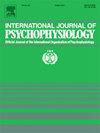Neural processing differences between Chinese emotion-label and emotion-laden words revealed by visual event-related potentials
IF 2.6
3区 心理学
Q3 NEUROSCIENCES
引用次数: 0
Abstract
The processing of emotional words plays a crucial role in everyday communication, yet the neurocognitive mechanisms underlying this process remain insufficiently understood. One particularly important question is whether and how emotion-label words (e.g., “happy,” “sad”) and emotion-laden words (e.g., “beauty,” “failure”) differ in neural processing. The present study investigated this issue by recording event-related potentials (ERPs) during a lexical decision task. Fifty-two native Chinese speakers were asked to classify 150 real words (30 positive-label, 30 positive-laden, 30 negative-label, 30 negative-laden, and 30 neutral words) and 150 pseudowords. Behavioral results showed faster reaction times and higher accuracy rates for emotion-label words compared to emotion-laden words. A data-driven mass univariate analysis revealed a significant frontal negative ERP deflection for emotion-label words relative to emotion-laden words around 400 ms after word onset. This emotional frontal effect around 400 ms (labeled as e-FN400) emerged as the most robust ERP difference between the two emotional word types, suggesting unique neurocognitive mechanisms engaged by emotion-label words. Possible functional roles of the e-FN400 are discussed, including its potential reflection of greater semantic density, enhanced episodic familiarity, and stronger embodied emotional activation associated with emotion-label words.
视觉事件相关电位揭示汉语情绪标签词与情绪负载词的神经加工差异
情绪词汇的处理在日常交流中起着至关重要的作用,但这一过程背后的神经认知机制仍未得到充分的了解。一个特别重要的问题是,带有情绪标签的词(如“快乐”、“悲伤”)和带有情绪的词(如“美丽”、“失败”)在神经处理过程中是否不同,以及如何不同。本研究通过记录词汇决策任务中的事件相关电位(erp)来研究这一问题。要求52名以汉语为母语的人对150个真实单词(30个积极标签词、30个积极标签词、30个消极标签词、30个消极标签词和30个中庸词)和150个假词进行分类。行为测试结果显示,与充满情绪的词汇相比,带有情绪标签的词汇反应速度更快,准确率更高。一项数据驱动的大规模单变量分析显示,在单词开始后400毫秒左右,情绪标签词相对于情绪负载词的正面负ERP偏转显著。400毫秒左右的情绪额叶效应(标记为e-FN400)是两种情绪词类型之间最强大的ERP差异,表明情绪标签词参与的独特神经认知机制。讨论了e-FN400可能的功能作用,包括它可能反映更大的语义密度、增强的情景熟悉度和与情绪标签词相关的更强的具身情绪激活。
本文章由计算机程序翻译,如有差异,请以英文原文为准。
求助全文
约1分钟内获得全文
求助全文
来源期刊
CiteScore
5.40
自引率
10.00%
发文量
177
审稿时长
3-8 weeks
期刊介绍:
The International Journal of Psychophysiology is the official journal of the International Organization of Psychophysiology, and provides a respected forum for the publication of high quality original contributions on all aspects of psychophysiology. The journal is interdisciplinary and aims to integrate the neurosciences and behavioral sciences. Empirical, theoretical, and review articles are encouraged in the following areas:
• Cerebral psychophysiology: including functional brain mapping and neuroimaging with Event-Related Potentials (ERPs), Positron Emission Tomography (PET), Functional Magnetic Resonance Imaging (fMRI) and Electroencephalographic studies.
• Autonomic functions: including bilateral electrodermal activity, pupillometry and blood volume changes.
• Cardiovascular Psychophysiology:including studies of blood pressure, cardiac functioning and respiration.
• Somatic psychophysiology: including muscle activity, eye movements and eye blinks.

 求助内容:
求助内容: 应助结果提醒方式:
应助结果提醒方式:


